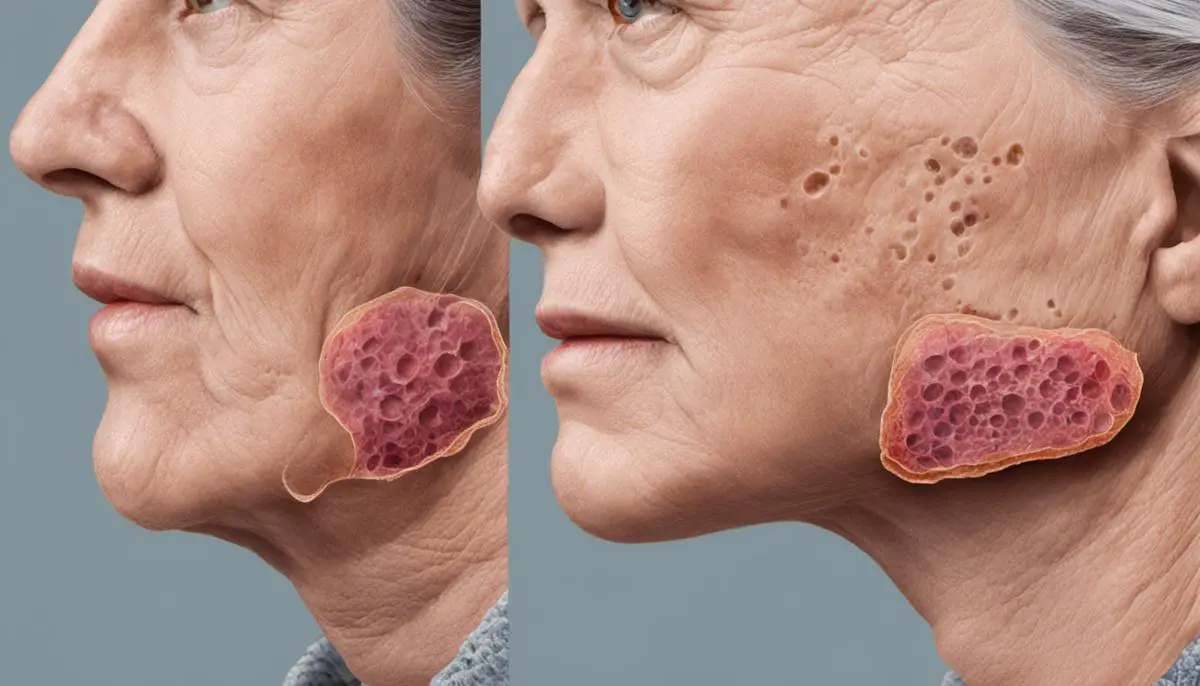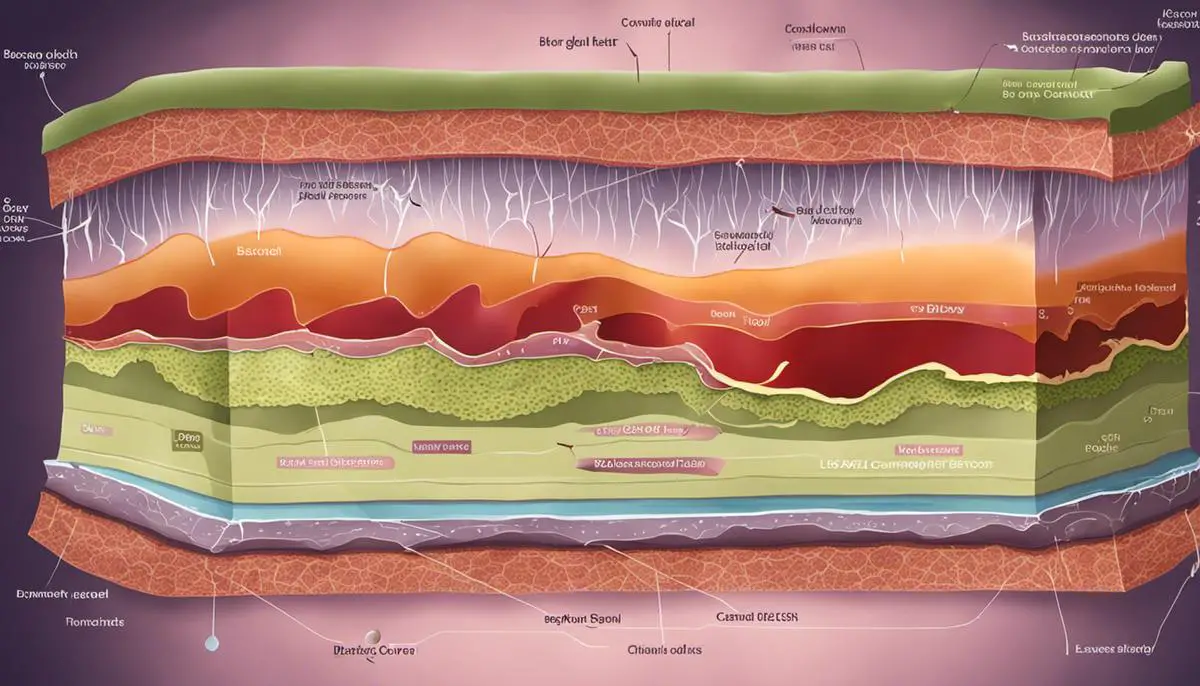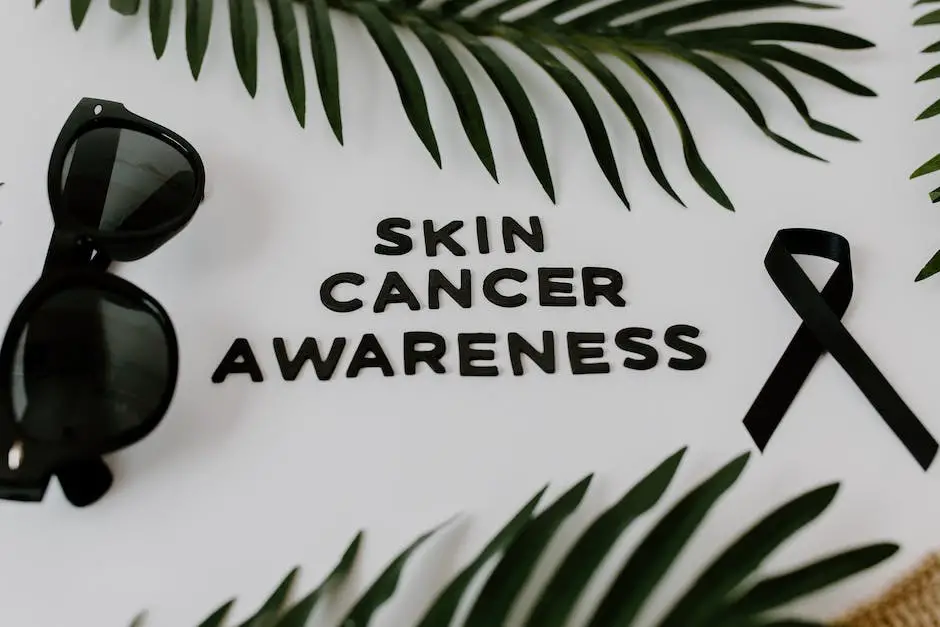Basal Cell Carcinoma (BCC) is a common form of skin cancer notorious for its potential to cause significant damage if left untreated. Widespread misunderstanding about this ailment can lead to unnecessary fear or complacency in those affected. This write-up seeks to elucidate on BCC comprehensively – its nature, progression if untreated, associated risk factors, available treatment options, and the complex question of whether ignoring it inevitably results in death.
Understanding BCC(Basal Cell Carcinoma)
Basal Cell Carcinoma: A Brief Overview
Basal Cell Carcinoma (BCC) is the most common type of skin cancer. It originates in the basal cells, which are found in the bottom layer of the epidermis, the outermost layer of skin. Although BCC mostly develops in areas frequently exposed to the sun such as the face and neck, it can occur anywhere on the body.
Signs and Symptoms of BCC
The sign of BCC often manifests as a change in the skin. It can appear as a patch of skin that is slightly different in color or a shiny bump that resembles a pimple or a pearl. BCC can also form as a red or pink growth, with slightly elevated rolled edges and a central indentation. At times, BCC might look like a lesion that bleeds, crusts, or has a scaly surface.
Causes of BCC
The primary cause of BCC is extensive exposure to ultraviolet (UV) radiation from the sun or tanning beds over time. People with fair skin, light hair or eyes are more susceptible to UV radiation and have a higher risk of developing this cancer. Genetics, exposure to radiation, a suppressed immune system, and other skin conditions also contribute to the risk factors.
Diagnosis of BCC
To diagnose BCC, medical professionals take a skin biopsy. This involves removing a small sample of the suspicious skin to be examined under a microscope. If the biopsy confirms BCC, additional tests may be performed to determine if it has spread to the lymph nodes or other parts of the body, although this is rare.
Does Untreated Basal Cell Carcinoma (BCC) Necessarily Lead to Fatality?
Basal Cell Carcinoma (BCC), in most cases, evolves slowly and possesses a low likelihood of metastasizing to other parts of the body. It’s significant to emphasize that fatalities directly resulting from BCC are fairly uncommon. Nonetheless, long-term neglect of BCC can result in its expansion into neighboring tissue and bone, potentially causing considerable damage.
There are rare scenarios where BCC, if untreated, can metastasize to other body parts and pose a risk to life. This usually occurs when the cancer is overlooked for an extended period or materializes in challenging treatment areas, such as proximity to the eyes, ears, nose, or brain.
While BCC is not commonly a cause of death, early detection and treatment are imperative to negate potential complications. Inaction can lead to long-term complications and, under severe circumstances, could result in fatality if the cancer metastasizes to critical organs. Hence, the prognosis for untreated BCC largely hangs on its specific location, the patient’s overall health status, and the length of time it’s been untreated.

The Progression of Untreated BCC
Demystifying Basal Cell Carcinoma (BCC)
Representing the most prevalent form of skin cancer, Basal Cell Carcinoma (BCC) diagnoses exceed four million every year in the United States alone. Originating from an abnormal, uncontrollable expansion in the basal cells—sited within the deepest layer of the skin’s exterior layer—BCC is a significant health concern.
The Progression of Untreated BCC
If left untreated, BCC can grow slowly and progress from the superficial layers of the skin into the deeper layers. Depending on the site and extent of invasion, it may erode surrounding tissues, causing damage that can be significant. As BCC grows, it may present as an open sore, a red patch, a shiny bump or nodule, or a scar-like area. Despite the dramatic appearance these lesions can sometimes take, BCC rarely spreads or metastasizes to other parts of the body, limiting its potential to be life-threatening.
In rare cases, BCC may invade bone and other tissues beneath the skin. When located close to key structures such as the eyes, ears, or nose, aggressive BCC lesions can lead to functional impairment and disfigurement.
Untreated BCC and Mortality
While Basal Cell Carcinoma is rarely deadly, it doesn’t mean it should be left untreated. Unlike other forms of skin cancer, it rarely spreads to other parts of the body, and death from BCC is exceedingly rare. However, if neglected for a long time, it can cause significant local destruction and disfigurement.
It’s also important to note that presence of BCC may be indicative of a weakened immune system or a predisposition to skin cancer, and individuals with a history of BCC are at risk to develop more skin cancers in the future, including the more dangerous melanoma. Therefore, prompt assessment and treatment are critical not only to address the BCC itself, but to ensure ongoing surveillance and preventive measures against other skin cancers.
Treatment of BCC
Treatment for BCC is primarily surgical, removing the cancerous cells and preserving as much skin and normal tissue as possible. Other treatments include topical chemotherapy, radiotherapy, or photodynamic therapy, often reserved for superficial BCCs or for lesions in challenging anatomical locations. Following treatment, patients should still maintain regular skin checks to identify and treat any new lesions early.
To sum up, letting untreated BCC continue without medical intervention won’t necessarily result in death, but could lead to substantial bodily harm. It’s also a red flag for a person’s increased vulnerability to other types of skin cancers. While not typically a direct cause of mortality, BCC should not be taken lightly. If you spot any unusual skin abnormalities, it’s highly advised to have them checked by a professional healthcare provider swiftly. Doing so can help you avoid the possible risks and complications associated with this prevalent type of skin cancer.

Risk Factors of Untreated BCC
A Closer Look at BCC and Its Risk Factor for Mortality
Basal Cell Carcinoma (BCC) holds the title for being the most typical kind of skin cancer. It’s often the product of heavy exposure to the sun, specifically, its ultraviolet radiation, or produced by regular usage of tanning beds. Though BCC can be lethal if left unchecked, it’s generally a slow-growing disease that can be well managed with early identification and appropriate medical intervention. Nonetheless, even though BCC isn’t commonly a direct cause of death, it can result in substantial long-term complications when neglected.
Factors Influencing BCC Progression and Risk
Multiple factors influence the progression of BCC and its risk to an individual’s health. Understanding the role of age, skin type, personal and family history, sun exposure, and other predisposing elements can help inform risk management strategies.
Effect of Age and Skin Type
It is observed that older individuals, especially those over 50, have a higher risk of developing BCC due to cumulative sun exposure over time. In addition, those with lighter skin types (types I-II on the Fitzpatrick scale) are more prone to sun damage and consequently have an increased risk of BCC.
Role of Personal and Family History
A personal or family history of skin cancer significantly heightens one’s risk of BCC. Individuals previously diagnosed with BCC have a predisposition to develop new cancers on other areas of their skin.
Impact of Sun Exposure and Other Predisposing Factors
Long-term, heavy exposure to the sun or frequent use of tanning beds increases the risk of developing BCC. Those living near the equator or at high altitudes, where sunlight exposure is intensified, carry a higher risk. Certain rare genetic disorders like Gorlin syndrome can also multiply one’s risk of BCC.
Consequences of Untreated BCC
Given its slow growth, BCC rarely spreads beyond the original tumor site. However, if left untreated, BCC may grow deep beneath the skin into underlying tissue and bone, causing significant damage. While it is not common, in severe cases, BCC can spread to other parts of the body and become life-threatening. This progression is called metastasis, but it is rare with BCC.
It’s also vital to acknowledge that BCC can significantly affect a person’s quality of life. Unmanaged BCC lesions can lead to disfigurement, physical discomfort, and emotional stress. Thus, while BCC might not directly lead to death frequently, it can cause considerable health complications that require attention.
The importance of early detection for Basal Cell Carcinoma (BCC)
Basal Cell Carcinoma, commonly abbreviated as BCC, is the most prevalent form of skin cancer and is typically found to originate from the basal cells positioned at the bottom of the skin’s outermost layer, the epidermis. The chances of survival with BCC are commendably high provided it’s detected and treated in its early stages. It becomes increasingly crucial then, for the general populace, particularly ones prone to a high risk, to consider adopting preventive measures. These may include actions such as regular application of sunblocks, avoiding excessive exposure to tanning beds, and scheduling regular skin inspections, thereby enabling early detection of any potential carcinomas.

Photo by bostonpubliclibrary on Unsplash
Treatment Options for BCC
Consequences of ignoring Basal Cell Carcinoma (BCC)
Whilst BCC is widely recognized as a slow-progressing cancer, neglecting its treatment can lead to severe disfigurement, functional impairment, and in rare scenarios, even death. BCC generally emerges on the skin segments that bear the brunt of sunlight exposure which predominantly include areas like the face and neck. Thus, irrespective of the typically low mortality linked to BCC, the potential consequences of untreated BCC emphasize the significance of routine dermatological evaluations and timely interventions.
Treatment Options for BCC
There are multiple ways to treat BCC, including surgical and non-surgical methods. The choice of treatment depends on several factors, such as the size and location of the tumor, the patient’s health status and personal preferences.
Surgical Treatments
Standard surgical excision involves removing the entire BCC along with a margin of normal skin around it. Mohs micrographic surgery is another surgical option that maximizes tissue preservation. It entails the removal of the tumor and immediate microscopic examination to verify complete removal. These procedures can be completed as outpatient procedures with local anesthesia.
Non-Surgical Treatments
For patients who cannot undergo surgery or choose against it, non-surgical alternatives like radiation therapy, topical medications, or photodynamic therapy can be employed. Radiation therapy uses high-energy rays to kill cancer cells with minimal damage to surrounding healthy tissues. Topical medications, like Imiquimod and 5-Fluorouracil, work by stimulating the immune system or by interfering with cell growth, respectively, to destroy the carcinoma. Photodynamic therapy involves using a special light source in combination with a drug that makes cells sensitive to light.
Prevention Strategies and the Importance of Early Detection
Prevention and early detection are key elements in managing BCC. Regular self-examination of the skin, use of sunscreen, and reducing exposure to UV radiation can significantly decrease the risk of developing BCC. Early detection increases the effectiveness of most treatments, limiting the potential for disfigurement and other complications.
Basal Cell Carcinoma (BCC) is a type of skin cancer that, while not typically life-threatening, can lead to significant health complications if left untreated. In rare instances, it may prove fatal if it invades deep structures such as nerves or blood vessels, triggers severe disfigurement or disability, or spreads to other parts of the body. That being said, such occurrences are extremely uncommon. Nevertheless, in order to prevent the disease progression, it’s crucial to seek timely medical help and follow through with the recommended treatment.

BCC and Mortality: Correlation or Causation?
Delving Deeper into Basal Cell Carcinoma (BCC)
BCC is, in fact, the most prevalent type of skin cancer, making up around 75% of all skin cancer cases. It originates from basal cells, which can be found in the deepest layer of the epidermis, the outermost layer of the skin. Even though BCC typically develops on parts of the body commonly exposed to the sun, such as the face and neck, it can essentially surface anywhere on the body.
Factors such as exposure to radiation, a family history of skin cancer, chronic inflammation of the skin, and prior skin injuries can heighten the chances of encountering this type of cancer.
Mortality Rate of Untreated BCC
Contrary to some perceptions, BCC is usually not life-threatening. In fact, the mortality rate from BCC is quite low. According to the Skin Cancer Foundation, even without treatment, a person may live for many years with the disease. However, untreated BCC can lead to significant discomfort, functional impairment, disfigurement, and potentially other complications if it invades deeper tissues or nerves.
Possible Progression of Untreated BCC
Despite having a low mortality rate, untreated BCC can have significant health consequences. They can grow and invade surrounding tissues, causing damage or disfigurement, especially if they’re located near critical areas like the eyes or ears.
In extremely rare cases, BCC can evolve into a more aggressive form known as invasive or infiltrative BCC. This type can spread to nearby lymph nodes, bones, or other organs, a process called metastasis. However, metastasis really occurs only in a small fraction (0.003%-0.55%) of all BCC cases.
BCC Treatment and Prognosis
Effective treatment for BCC typically includes surgical removal of the tumor, topical treatments, photodynamic therapy, or radiation therapy, all of which have high cure rates when the cancer is detected early. Even in cases where the BCC has become invasive, there are therapeutic options, including systemic therapies that have shown success in treating the disease.
Impact of Delayed or No Treatment for BCC
Delaying treatment or failing to treat BCC can lead to higher costs down the line, both financially and in terms of health outcomes. The larger a tumor grows, the more complex treatment may be, and the greater the chance of disfigurement or functional impairment.
In conclusion
While untreated BCC does not always lead to death, it can cause significant morbidity and have a profound impact on quality of life. It is imperative to address any suspicious skin lesions promptly with a medical professional, to facilitate early detection and treatment of BCC, thereby ensuring the best possible prognosis.

Though Basal Cell Carcinoma can be harmful and cause significant damage, it does not necessitate a death sentence. Yes, it could potentially have dire consequences if left untreated, but understanding risk factors and available treatment options significantly mitigate this risk. We can not overstress the necessity of professional healthcare intervention in BCC. Cultural shifts toward preventing sun damage, utilizing sunscreen, and scheduling regular check-ups can reduce the prevalence and progression of this skin cancer. Knowledge, it turns out, is not just power but also prevention and potential healing when dealing with Basal Cell Carcinoma.
